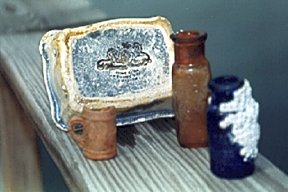Asfalto
- Type:
- shipwreck, schooner barge
- Specs:
- ( 330 x 40 ft )
- Sunk:
- March 12, 1932
- Depth:
- 95 ft
Capt. Mick Trzaska of the dive boat CRT II also calls this the "Bomb Wreck", since it once produced a live aircraft-type explosive. A diver had sent it up with a lift bag thinking it was a champagne bottle! How it got there is anyone's guess.
Asfalto

The Asfalto is one of the less-frequented wrecks off Long Island, New York's south shore. She sits in 95 feet of water 16 miles southwest of Jones Inlet, an area known as Wreck Valley. The Asfalto is an unidentified wreck, but she is thought by some to be a schooner barge that was sunk on March 12, 1932. She is approximately 300 feet long, has a 40-foot beam and a steel hull. Although not confirmed, it is also believed that there is a second wreck on the site, possibly the tug which was pulling the barge. This would make sense because many times a sinking barge would pull down the tug before the tow cable could be cut. Whether one wreck or two the site is also known as the Cindy, Rudder or X-Ray Wreck, depending on which dive captain you ask.
The Asfalto's remains are low-lying and scattered over a very large area. There are few easily distinguishable landmarks so it's recommended that divers utilize dive reels for navigation. Inside her hull divers will find all sorts of artifacts dating back to the late 1800s. Over the years divers have brought up everything from bottles and china to silverware and even a ceramic spittoon. On most shipwrecks, divers must dig in order to find artifacts but the Asfalto is literally filled with a seemingly unending supply of prized artifacts. If correct, the assumption is that the Asfalto is an old garbage barge that was most likely transporting garbage from New York City to an offshore dumping ground. What divers find is the non-bio-degradable remains of what the barge had been transporting.

Bottles, silverware, ceramic pieces, and bone have remained in near perfect condition, unharmed after over 60 years of immersion in the powerful Atlantic. Note that the bottom composition here is very silty. This silt can and quickly does get kicked up by divers digging on or exploring the wreck. Almost instantly visibility can be temporarily reduced to near zero. This is just one reason why good navigational skills are the key to becoming a good wreck diver. Marine life on the site is also quite abundant, but for divers, the Asfalto's main attraction is her abundance of artifacts. This wreck is so productive that it is not at all uncommon for divers to find an entire bottle collection in only one dive.
The Asfalto may not be as well known or as popular as some of Wreck Valley's larger more historical wrecks, but she is certainly one of the most productive bottle dives on the East Coast.
Excerpted from Wreck Valley CDROM by Dan Berg



Questions or Inquiries?
Just want to say Hello? Sign the .